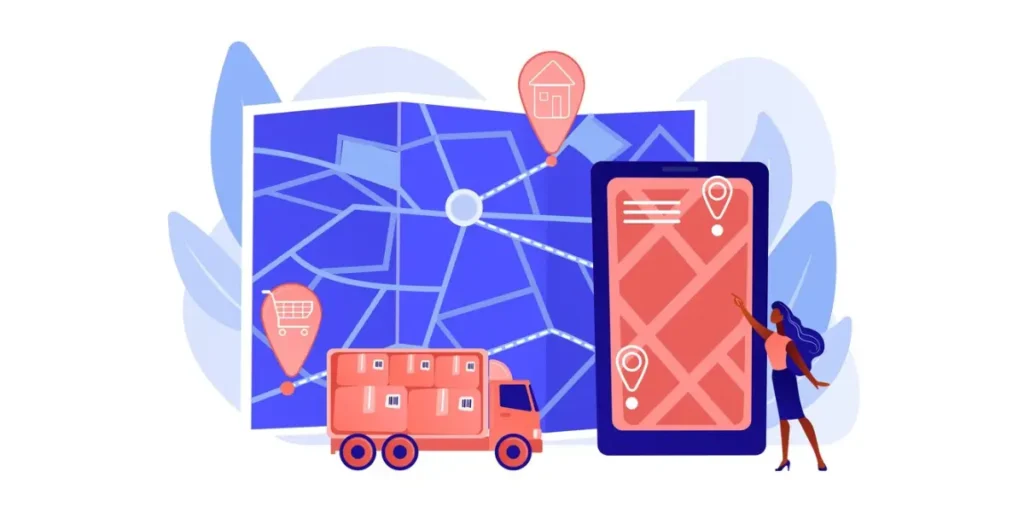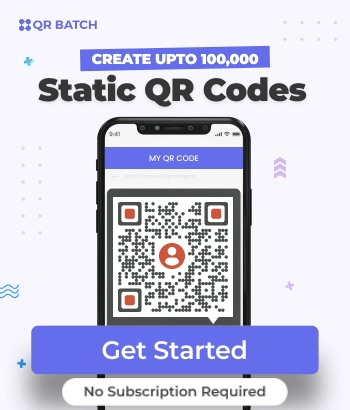Ever find yourself buried under a mountain of spreadsheets, trying to keep track of every last item in your warehouse? Or maybe you’re constantly playing a game of hide-and-seek with your inventory, never quite sure where that elusive widget ended up?
Well, fear not, because we’re about to introduce you to a game-changer: QR Codes for inventory management!
Yes, those funky little squares you’ve seen popping up everywhere from restaurant menus to product packaging. They are here to revolutionize the way you track and manage your inventory.
In this blog, we’re diving deep into the world of QRs and exploring how they can make your life easier, your inventory more organized, and your business more efficient.
So grab a cup of coffee (or your beverage of choice), settle in, and get ready to say goodbye to inventory headaches once and for all!
A. What are QR Codes for inventory tracking

Imagine having a magic wand that could instantly organize and track every item in your inventory with just a flick of your wrist.
Well, that’s pretty much what QR Codes for inventory tracking are!
QR Codes, short for Quick Response codes, are those funky little squares made up of black modules arranged on a white background. They might look like modern art, but trust us, they’re much more practical than that.
These nifty codes can store all sorts of information, from product details to serial numbers, in a format that’s easily scannable by smartphones and other devices.
So, how does it work? It’s simple. You slap a QR onto each item in your inventory – whether it’s a box of widgets or a batch of freshly baked cookies – and voila!
With a quick scan, you can instantly access all the juicy details about that item, like its name, quantity, location, and even its expiration date if you’re dealing with perishable goods.
But the real magic happens when you start using QR Codes in conjunction with inventory management software.
Suddenly, you’re not just tracking individual items – you’re orchestrating a symphony of inventory movements, from incoming shipments to outgoing orders and everything in between.
And with real-time updates and notifications, you’ll always know exactly what’s going on in your warehouse, no crystal ball required.
B. Who can use QR Codes for inventory tracking

1. Small businesses and retailers
Whether you own a quaint coffee shop or a local boutique, QR Codes can be your inventory superhero. They’re like having a personal assistant to keep track of your stock levels and reorder when needed.
2. Online sellers and e-commerce platforms
From Etsy artisans to eBay power sellers, QR Codes can streamline inventory management for online businesses. You can easily track product variants, manage listings, and fulfill orders with just a scan.
3. Manufacturers and suppliers
QR Codes aren’t just for finished products – they’re also handy for tracking raw materials, components, and supplies. Manufacturers can use them to monitor production progress and optimize supply chain efficiency.
4. Restaurants and caterers
Imagine being able to track every ingredient in your kitchen with a simple scan. QR Codes make it possible, helping restaurants and caterers keep tabs on inventory levels, reduce waste, and ensure freshness.
5. Healthcare facilities and pharmacies
In the world of healthcare, accurate inventory management is crucial. QR Codes can help hospitals, clinics, and pharmacies track medical supplies, medications, and equipment, ensuring that nothing falls through the cracks.
6. Warehouses and logistics companies
For businesses with large-scale inventory operations, QR Codes are a game-changer. They can help warehouses and logistics companies track the movement of goods, optimize storage space, and streamline order fulfillment processes.
7. Event planners and rental services
Whether you’re organizing a wedding, a corporate event, or a backyard barbecue, QR Codes can simplify inventory management for event planners and rental services. You can easily track rental items, manage bookings, and coordinate deliveries with ease.
75% of all supply chain management professionals want to improve their inventory management practices.
C. How to create QR Codes for inventory tracking

Since you need a large number of QR Code labels, creating them one by one isn’t practical. You’ll want to use an online bulk QR Code generator tool.
For our demonstration, we’ll be using QR Batch to create bulk QR Code labels. With QR Batch, you can create several types of QR Code batches, including:
– Website URL QR Codes
– Vcard QR Codes
– Plain Text QR Codes
– Serial Code QR Codes
– Random Code QR Codes
Here’s a step-by-step guide to creating QR Codes on product packaging:
1. Specify the data
You’ll need to create a spreadsheet with your data to generate QR Codes for website URLs, Vcards, or plain text. Follow our detailed guide for creating one.
For this article, we’ll focus on specifying data for text QR Codes. Simply:
i. Visit the QR Batch and select the Plain Text option.
ii. Upload your spreadsheet.
iii. Review the uploaded file by matching its columns with the QR Code fields. Confirm your selections.
iv. Once all details are entered, click Next.
2. Design your QR Codes
After specifying the data, you’ll see two QR Code designs: Standard and Custom Logo. You can proceed with either.
Customizing your QR Codes with a logo and brand colors can attract more scans than standard black-and-white ones. Customized QR Codes are ideal for marketing and promotions.
3. Specify label size and details
– After designing your QR Code batch, select the QR Code design.
– A pop-up will appear to define the batch name. Choose the export option “QR Code labels PDF.”
– Specify the QR Code size, indicating the labels per sheet (ranging from 1-80 labels per sheet).
– You’ll receive a comprehensive label specification, including sheet size, labels per sheet, margin, shape, and Avery compatibility. Review and click Next.
4. Make payment
– QR Batch charges only for the QR Codes you create, with rates decreasing as the number of QR Code labels increases.
– Estimate the batch price using the QR Batch Price Calculator.
– For instance, one QR Code costs $0.50, while 50 QR Codes cost $13 ($0.26 per QR Code).
5. Download your QR Code batch
– After payment, your QR Code Batch will be generated, taking a few minutes for smaller batches or up to an hour for larger ones.
– Download your batch from the Download Batch section, where you’ll receive notifications about the process and completion.
– Your QR Code Label PDFs will be in a zip folder. Unzip it, open a PDF, and scan a QR Code to test the output.
Now, you’re ready to print your QR Codes on compatible Avery or equivalent sheets using your home or office printer.
Here’s what our customers have to say about our product:
D. Why use QR Codes for inventory tracking

QR Codes for inventory tracking? They’re like your secret weapon for keeping things running smoothly. Here’s why they’re such a game-changer:
1. Efficiency
Think of QR Codes as your time-saving sidekick. They make inventory management a breeze, cutting out all the manual work and keeping things moving along smoothly.
2. Accuracy
Say goodbye to guesswork! With QR Codes, you can trust that your inventory levels are spot on, so you’ll never run out of stock when you need it most.
3. Cost-effectiveness
Who doesn’t love saving money? QR Codes help you do just that by minimizing waste and optimizing your inventory levels, so you’re not spending a dime more than you need to.
4. Accessibility
Don’t worry if you’re not a tech whiz – QR Codes are super easy to use. They’re designed to be user-friendly, so even the least tech-savvy among us can master them in no time.
5. Scalability
Whether you’re a one-person operation or a big-time business, QR Codes can scale up or down to fit your needs. So you can focus on growing your business without worrying about outgrowing your inventory system.
6. Organization
Say hello to a clutter-free inventory system! QR Codes keep everything neat and tidy, so you always know exactly where everything is – no more searching high and low for that one elusive item.
7. Customer satisfaction
Happy customers are the name of the game, right? With QR Codes, you can ensure that orders are fulfilled quickly and accurately, keeping your customers coming back for more.
The intention to incorporate mobile devices into inventory management to increase speed is shared by 67% of warehouses.
E. Where to use QR Codes for inventory tracking

Let’s talk about where you can sprinkle some QR Code magic into your inventory tracking:
1. Retail stores
From the shelves to the stockroom, QR Codes can help you keep tabs on inventory levels, making restocking a breeze.
2. Warehouses
Picture this – rows upon rows of shelves, each tagged with a QR Code. With a quick scan, you can track every item’s location and quantity in the blink of an eye.
3. Manufacturing facilities
QR Codes aren’t just for finished products. You can slap them on raw materials and work-in-progress items to monitor production processes and ensure everything’s running smoothly.
4. Online stores
Managing inventory for your e-commerce empire? QR Codes can help you stay organized behind the scenes, making sure you never oversell or miss out on a sale.
5. Restaurants and bars
Keep your kitchen stocked and your patrons happy with QR Codes on ingredients, supplies, and even menu items. No more running out of the essentials halfway through the dinner rush!
6. Healthcare facilities
Hospitals, clinics, and pharmacies can use QR Codes to track medical supplies, medications, and equipment, ensuring everything’s where it needs to be when it’s needed most.
7. Event planning
Whether you’re coordinating a wedding, a conference, or a music festival, QR Codes can help you keep track of rental items, manage logistics, and ensure everything goes off without a hitch.
Inventory and warehouse management is increasing in value and relevance. The number of warehouses in the U.S. has risen 6.8% over the last five years.
F. When to use QR Codes for inventory tracking

Timing is everything, right? Let’s talk about when to whip out those QR Codes for inventory tracking:
1. At the point of receipt
As soon as inventory arrives at your doorstep, slap on a QR Code. That way, you can scan it into your system right away and avoid any confusion later on.
2. During stocking or storage
Whether it’s on the shelves, in the warehouse, or tucked away in a storage room, QR Codes make it easy to keep track of where everything is and how much you’ve got.
3. Before fulfilling orders
About to send out a shipment? Scan those QR Codes to double-check that you’ve got everything you need and that nothing’s gone missing since the last time you checked.
4. When taking inventory
Say goodbye to those marathon inventory counts! With QR Codes, you can breeze through your stocktake in no time, scanning items as you go and updating your records on the spot.
5. During audits or inspections
Are auditors knocking on your door? No problem! QR Codes make it a snap to verify your inventory levels and ensure everything’s in tip-top shape.
6. For traceability and recall purposes
In the unfortunate event of a product recall or quality issue, QR Codes can help you quickly identify affected items and take swift action to rectify the situation.
7. Anytime you need real-time updates
With QR Codes, your inventory data is always up to date. So whether you’re tracking stock levels, monitoring shipments, or forecasting demand, you’ve got the latest info at your fingertips.
Brands that trust us:
G. Benefits of using QR Codes for inventory tracking

Let’s break down the perks of tapping into QR Codes for inventory tracking:
1. Efficiency boost
QR Codes streamline inventory management, cutting down on manual data entry and making the whole process faster and more accurate.
2. Accuracy assurance
Bid farewell to inventory errors! QR Codes ensure precise tracking of stock levels, minimizing the risk of stockouts, overstocking, or misplaced items.
3. Cost savings
By improving efficiency and accuracy, QR Codes help businesses save money. You’ll waste less, optimize inventory levels, and reduce the need for costly emergency restocking.
4. User-friendly setup
Don’t fret about tech headaches – QR Codes are easy to implement and use. No fancy training is required; just scan and go!
5. Flexibility and scalability
Whether you’re a one-person show or a bustling enterprise, QR Codes adapt to your needs. They grow with your business, ensuring you’re always on top of your inventory game.
6. Organization nirvana
Say hello to a clutter-free inventory system! QR Codes keep everything neat, so you’re never left scratching your head over where that elusive item went.
7. Enhanced customer satisfaction
Happy customers, happy business. With QR Codes, you can fulfill orders faster, minimize errors, and keep your clients smiling from ear to ear.
H. Best practices: QR Codes for inventory tracking

1. Pick a consistent spot for QR Codes
Think of it like choosing a designated parking spot for your car. Having a set place for QR Codes on your inventory items makes them easy to find and scan whenever you need to.
2. Use tough materials for QR Codes
You wouldn’t wear flip-flops in a snowstorm, right? Similarly, make sure your QR Codes are tough enough to handle whatever your inventory throws at them – think sturdy labels or laminated prints.
3. Pack in the important details
Your QR Codes are like mini information packets. Make sure they include all the crucial stuff, like item names, numbers, where they’re stored, and how many you’ve got.
4. Keep ’em fresh with updates
Think of updating your QR Codes like watering your plants – do it regularly, and they’ll thrive. Keep them current with any changes to your inventory, so you always know what’s what.
5. Sync up with your software
It’s like making sure your phone and laptop are on the same page. Sync up your QR Code scanning with your inventory software for smooth sailing and real-time updates.
6. Teach your team the QR Code ropes
Ever tried to use a new gadget without reading the instructions? Yeah, not fun. Make sure your team knows how to scan and interpret QR Codes properly, so there are no hiccups down the line.
7. Double-check for accuracy
Just like proofreading an important email, take the time to double-check your QR Code scans. Regular spot checks can catch any slip-ups and keep your inventory shipshape.
8. Back up your QR Code data
Think of it like saving your work on a computer – back up your QR Code data regularly to avoid any “uh-oh” moments. That way, even if something goes wrong, you’ve got a safety net.
9. Keep an eye on performance
Monitoring how your QR Codes are doing is like keeping track of your favorite team’s stats. Keep an eye on things like how often they’re scanned and how accurate the data is, so you can tweak things as needed.
10. Stay in the loop with QR Code tech
Think of staying updated on QR Code tech like keeping up with the latest gossip – it helps you stay ahead of the game. Stay tuned for any new features or improvements that could make your inventory tracking even better.
I. FAQs: QR Codes for inventory tracking

1. What exactly are QR Codes, and how do they work for inventory tracking?
QR Codes, or Quick Response codes, are those square-shaped barcodes you often see on products or packaging. They work by encoding information that can be scanned and read by smartphones or other devices.
For inventory tracking, each item is tagged with a unique QR Code containing details like product name, quantity, location, etc. When scanned, this information is instantly accessible, making it easy to track and manage inventory.
2. Do I need special equipment or software to use QR Codes for inventory tracking?
Nope, not at all! All you need is a smartphone or a device with a QR Code scanner app, which you can easily download for free.
As for software, there are plenty of inventory management systems available that offer QR Code scanning capabilities, but it’s not a requirement. You can still use QR Codes effectively with just a scanner app and a spreadsheet if that’s more your style.
3. How do I create QR Codes for my inventory items?
Creating QR Codes is a breeze – you can create them in bulk using QR Batch. Once you’ve got your code, you can print it out on labels or stickers and attach them to your inventory items.
4. Are QR Codes secure? Could someone tamper with them or duplicate them?
QR Codes themselves aren’t inherently secure, but you can take steps to make them more tamper-resistant. For example, using durable materials for printing QR Codes and storing them in secure locations can help prevent tampering.
As for duplication, each QR Code should contain unique information for each item, making it difficult to duplicate without access to your inventory data.
5. Can QR Codes help with inventory audits or stocktakes?
Absolutely! QR Codes make inventory audits a breeze. Simply scan each item’s QR Code as you count it, and your inventory management system will automatically update with the new counts. It’s way faster and more accurate than manual counting, trust me.
6. What happens if a QR Code gets damaged or lost?
No worries! If a QR Code gets damaged or lost, you can simply generate a new one with the same information and attach it to the item. Most inventory management systems will let you update the QR Code information manually if needed, so you can keep everything in sync.
7. Can QR Codes help with tracking items that move frequently or are stored in different locations?
Absolutely! QR Codes are super versatile and can be used to track items no matter where they are or how often they move. Just make sure to update the location information in your inventory management system whenever an item is moved, and you’ll be good to go.
Summing Up
Whether you’re a mom-and-pop shop or a big-time corporation, QR Codes can revolutionize the way you handle your inventory. They’re versatile, easy to use, and can make your life a whole lot easier.
Until next time, keep scanning, keep organizing, and keep making your inventory management dreams a reality. You’ve got this!


